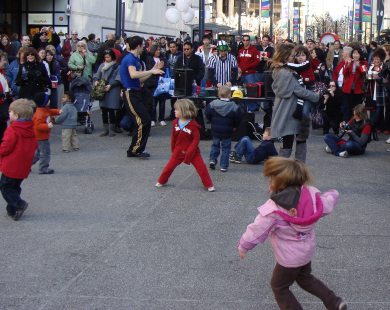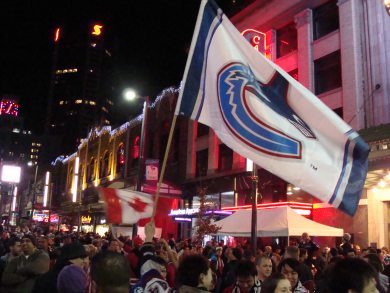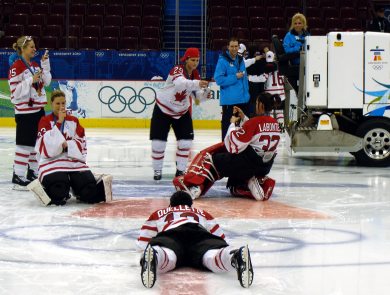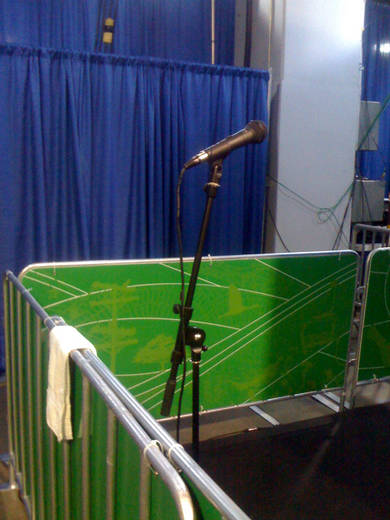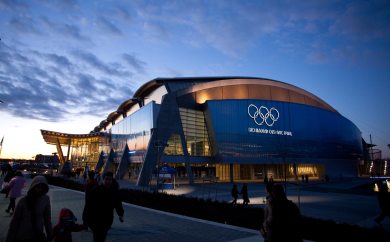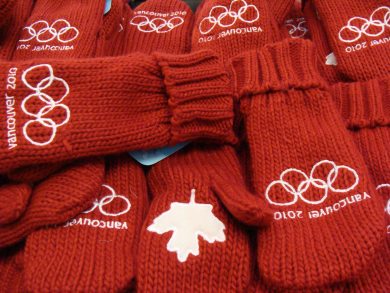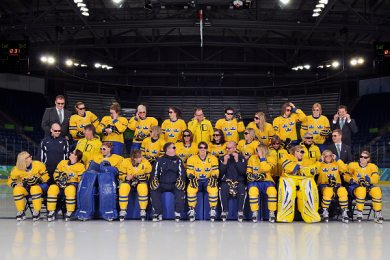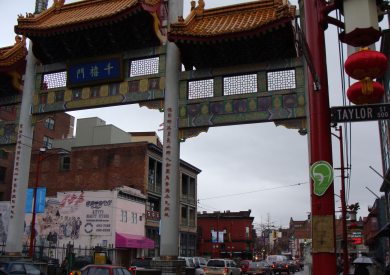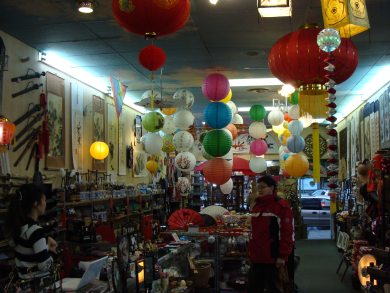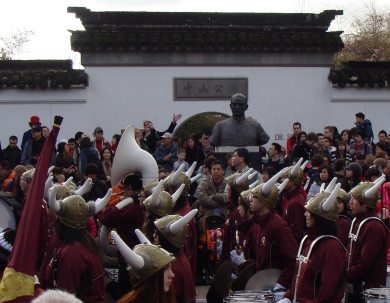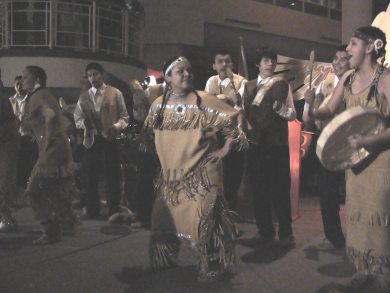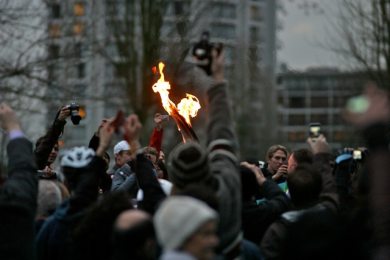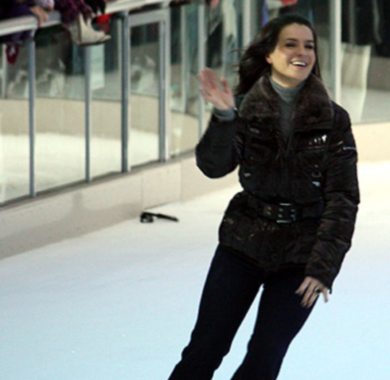|
Welcome to the 2010 Olympics hockey blog. Throughout the Olympics you will be able to read about our impressions behind the ice and side stories from Vancouver.
February 28 / Lucas Aykroyd
One hour until the gold medal game between Canada and the United States. The stands here at Canada Hockey Place are already starting to fill up with fans and media, the electricity growing.
Besides the big game itself, what will I carry away in my mind from the unforgettable month of February 2010? So many vivid images and moments, in no designated order, from a hometown Olympics for me.
Riding a BC Ferry from the Sunshine Coast into West Vancouver's Horseshoe Bay on February 5, a brilliantly sunny and windy day – the first day the torch entered Greater Vancouver.
On balance, it was the Olympics of pink cherry blossoms and light rain: the first Spring Olympics.
The kid swooping around in the skies and fields and the giant illuminated polar bear made up for the fourth arm of the torch not coming up at the opening ceremony.
Gone but not forgotten: Nodar Kumaratishvili.
Looking up from my laptop to see Alexander Ovechkin absolutely demolish Jaromir Jagr with a hit at centre ice – unfortunately for the big Russian, it was probably his best moment of the tournament, rather than, say, scoring the winning goal in the gold medal game.
At the Czech-Slovak round-robin game, sitting in between my parents and Paolo Ianieri, who was the IIHF media relations manager when I started writing for the IIHF web site nearly ten years ago at the 2000 World Championship in St. Petersburg, Russia. Feeling like everything has come full circle.
Certainly, seeing Bryan Adams (one of my early rock faves) and Nelly Furtado (with whom my sister went to high school) perform together at the opening ceremony augmented that feeling.
I met Katarina Witt. Enough said.
Seeing Jagr swoop down on a breakaway and score the winning goal against Slovakia. In the Olympics. From a pure hockey perspective, does it get any better than that?
Sidney Crosby's shootout winner against Switzerland: nothing fancy, just a hyper-quick release a la “Burnaby Joe” Sakic.
I will forever associate “I Gotta Feeling” by the Black Eyed Peas with Olympic hockey after hearing it a million times at Canada Hockey Place. The song sounded a lot better here than when I saw the group open for U2 at neighbouring BC Place Stadium with its boomy acoustics back in October.
The strange feeling of being in my “home arena” and yet being on another planet, since Canada Hockey Place was completely revamped in the Olympic blue-and-green colour scheme.
Going through the fastest security lineups I've ever experienced at an Olympic Games, much more efficiently run than Salt Lake City or Turin.
Taking the SkyTrain every day to get to the hockey arena. I spent much more time than usual on Vancouver's rapid transit link: it felt like being in New York or London, where subway trips are routine.
Being lucky enough to cover the Finland-Germany game where Teemu Selänne surpassed Valeri Kharlamov, Vlastimil Bubnik, and Harry Watson for the all-time Olympic points lead.
On the not-so-smooth side, Miikka Kiprusoff's awful giveaway to Ryan Malone on the opening goal in the USA-Finland semi-final.
The sheer happiness on the faces of the Finnish players' faces as they were accepting their bronze medals after coming back to beat Slovakia 5-3. One Finnish journalist told me: “When Valtteri Filppula scored the empty-netter, that was the first time I've seen Saku Koivu smile all tournament.”
Olli Jokinen's winner against Slovakia came straight out of the old-school Mark Messier playbook: a heads-up rush down the middle, capped off with the backhand through Jaroslav Halak's five-hole.
Watching Sweden's Peter Forsberg out there hunting, futilely, like a brave old dog, for the equalizer late in the quarterfinal versus Slovakia, and wondering why he was still being counted on to carry the load for Tre Kronor, bad foot and all.
Shea Weber's enormous hit on Maxim Afinogenov deep in the Canadian end in the apocalyptic Canada-Russia quarterfinal. Sensing the change in tone at that moment, and realizing things were almost certainly going to go very much Canada's way.
Getting confirmation of that when Russia's Evgeni Nabokov struggled mightily between the pipes – especially when he surrendered the 4-1 goal to Brenden Morrow on a wraparound he should have had.
Roberto Luongo's last-minute stops on Slovakia's Pavol Demitra to save the day for the host team.
The peaceful, out-in-the-country setting for the women's games at the UBC Thunderbird Arena on the greenery-laden University of British Columbia campus.
Being surprised at all the fuss about the Canadian women's team on-ice celebration, which took place right in front of me in the press tribune. Hockey players being hockey players.
Seeing IOC Jacques Rogge president walk right past me at the Molson Canadian Hockey House launch of a cookbook entitled Hockey Soups: Soup Recipes From Around the World, undoubtedly one of the most innovative and unusual birthday presents IIHF president René Fasel (a big fan of soup) has ever received.
The people everywhere in downtown Vancouver, lining up for hours for the pavilions, high-fiving, whooping, and wearing those red Maple Leaf jerseys. The most boisterous yet happy crowds I've ever seen in this city, the vibe somehow even more euphoric than after a big Vancouver Canucks win.
Hopefully some of that good Olympic mood will linger after these Games are long gone.
February 27 / Martin Merk
As we prepare for the gold medal game, Vancouver’s vibrant heart is currently the entertainment district on Granville Street, most noticeable where it intersects with Robson Street.
Car drivers have to be patient downtown during the Olympics. More than normally, lanes or complete streets may be blocked and transformed into a pedestrian zone for a few blocks, depending on the amount of people celebrating the Olympics.
During the day, it’s time to stroll through the streets packed with shops and restaurants, while the streets are filled with jugglers, musicians and other artists. There are music performances, from country stylings to aboriginal flavours. You might get a taste of European heritage with Scottish bagpipes, or with a Swiss Saint Bernard dog hanging out.
Daytime is great for the kids, who love the street artists, music, and shows.
At sunset, Granville turns into a party strip for teens and 20-somethings, and is mostly coloured with the host nation’s red and white, apart from some international guests sporting jerseys and flags from all the teams that have participated in Olympic hockey.
The crowd is loud. Cries of revelry are part of the atmosphere, along with people jumping on wooden platforms, ghetto blasters, open-air DJs, and the smells of pizza, Asian fast food and all kinds of smoke.
The police constables have their hands full, even when passersby simply want to high-five with the officers. But they’ve been doing a great job with a huge amount of patience, and the crowds have generally been well-behaved.
Granville Street is crowded at night, the sidewalks sometimes full of people queuing up for pubs and clubs. On the weekend, it can be so crowded that one can hardly fall down. And it won’t be any different after the Canada-USA gold medal game on Sunday afternoon.
Everything is set for a great game and hopefully another peaceful day of partying on Granville Street, no matter who wins and who settles for silver.
February 25 / Martin Merk
You don’t win an Olympic gold medal every day, so you should take your time enjoying the moment.
After all, it's been quite a while since Turin 2006. Four years to be exact. And it came down to 60 long minutes of the world’s best women’s hockey against a competitive U.S. team. Then, it was a matter of waiting for the medal ceremony. Waiting until the bronze and silver medals were handed out to the Finns and Americans, before it was the moment of the Canadian ladies. The moment they received their gold medals, and flowers. For some it was the first time, for others the third. There was happiness in all faces, from 18-year-old scoring hero Marie-Philip Poulin to 35-year-old defensive veteran Becky Kellar.
After answering media questions and continuing the celebrations in the locker room, some of the players couldn’t resist going out and celebrating the victory where they achieved it – on the ice. They opened some more bottles of champagne and posed for photos, in all possible positions, with glasses, cans and other things, standing, lying, or sitting on the Olympic Zamboni.
And, why not? The Canadians have just won the greatest women’s hockey tournament ever, and it will be four more years until Sochi 2014, plus slightly more than a year until the next World Women’s Championship, when they might be challenged again by the Americans for gold.
February 25 / Risto Pakarinen
Coaches don’t get medals in the Olympics, even in hockey, a sport where the coach is somewhat relevant. At times. But Pekka Hämäläinen, head coach of Finland’s women’s hockey team, was all smiles after the bronze medal game. The memory, the experience, the overtime win, nobody can takes those away from him.
Some 29 years ago, Hämäläinen was the star defenceman of JoKP, a team in my howetown at a time. Back then, the only pro players in the world were in the NHL, and Finnish players still actually “turned pro” when they left the country. Some were carpenters, some were students, or “students”. Pekka Hämäläinen was the part-time editor-in-chief of an advertorial distributed to every household in the city. It had TV listings, a lot of classified ads, and couple of sports stories.
One of them was the “Player of the Week”, which usually featured Hämäläinen’s teammates.
Except one week, early in the 1981-1982 season, when that player was me. We had hosted a junior tournament in the city, and done pretty well, so they picked me. Or he did.
The interview took place in my father’s office in an appliance store downtown. Pekka sat in the big chair behind a desk, and I, 13 years old, sat down on the other side. Pekka asked, I answered. The basic format was very simple, more than an interview, or a story, it was a fact box about the player in question so I knew what was coming.
I caught Pekka by surprise today when I returned the favor by posing the same questions back to him. Ready? All you need to know about the bronze medal coach:
Name: Pekka Hämäläinen
Born: July 19, 1953 in Joensuu, Finland (note: At home in Mutalantie 19, not in a hospital, he added.)
Position: Defenceman / coach
Favorite food: Pepper steak
Favorite drink: “With that, red wine”.
Favorite music: Rock’n’roll
(Note here: I had practiced my answers, so I told him I listened to all kinds of music. He stopped writing, looked at me, and asked, “classical, too?” I said no, and he said, “I’ll just put down ‘pop’.” Pekka really did say rock’n’roll, though.)
Worst opponent: Myself
Goals: To win gold in Sochi.
Below is Pekka. No photo of a 13-year-old me available. I'm sorry.
Not really.
February 24 / Lucas Aykroyd
As I sit here in the press tribune at Canada Hockey Place, just hours from the start of today's highly anticipated Canada-Russia quarterfinal, I can't help thinking back to the first big game I personally remember between these two archrivals.
I was six years old, and I watched the one-game 1981 Canada Cup final on a tiny black-and-white TV with my dad in our living room in Victoria, British Columbia. Needless to say, it remains one of the most infamous episodes in Canadian hockey history, as the Soviets pounded Canada 8-1 at the Montreal Forum and Sergei Shepelev scored a hat trick.
I don't remember my reaction to specific plays or goals. I just remember the Russians kept scoring. And scoring. And scoring.
My dad was shocked and kept referring to it as a "slaughter." I didn't know what "slaughter" meant. I thought he was saying "slotter." Which, I assumed, must have been a technical term for the Russians shooting from the slot, or slotting lots of pucks past Canadian goalie Mike Liut, or something.
Then again, at this time, I also thought a "rookie" had something to do with birds, and that when players were sent down to the "farm team," they spent their time between games milking cows and bringing in the hay.
I just couldn't believe that the host team, which in my mind had the two greatest forwards in the world in a young Wayne Gretkzy and the legendary (although starting to fade) Guy Lafleur, could lose by such an overwhelming score. To a bunch of mysterious, stone-faced men in red jerseys.
Incidentally, my IIHF.com colleague Risto Pakarinen just stopped by and told me his most memorable moment from the '81 final, which was shown on tape delay in his native Finland.
Probably the Russian goal that best epitomized Canada's woes was scored by 2010 IIHF Hall of Fame inductee Vladimir Krutov. He zoomed over the Canadian blueline and faked a slapshot, causing the bare-headed Lafleur, who was back covering on defense, to recoil and move out of the way. "The Tank" then gobbled up the open ice and snapped the puck home.
According to Risto, the Finnish announcer commented: "See, kids, that's what happens when you don't wear a helmet."
February 23 / Risto Pakarinen
Hockey players are pretty tough, we know that. When Alexander Ovechkin stopped Jaromir Jagr dead on his tracks in the neutral zone with a bone crushing - or so it sounded - body check, Jagr didn’t complain. He even said that the turnover that led to Russia’s goal hurt more than the hit.
Sweden’s goaltender Henrik Lundqvist stopped two Finnish shots with his face mask, on purpose.
"I don't want to put my glove in front of shots that come towards my eyes, in case the puck will bounce off somewhere, so I'd rather put my head in the way," Lundqvist said.
The players also happily block Sami Salo’s shots, try to squeeze between the boards and Zdeno Chara, and drop their gloves to defend a teammate.
But there is one thing that seems to put fear into them.
A microphone.
The organizers have set up several interview spots with microphone stands and loudspeakers so that all reporters could hear what the stars have to say. But when Jaromir Jagr came out after the game against Russia, he refused to speak into the mic. When asked about it, the Czech media person said that Jaromir didn’t want to. Lundqvist turned the microphone away, as well.
In fact, with the exception of Sidney Crosby - who really doesn’t have a choice because the number of reporters stretching their arms to get a recorder under his nose is just too big - most of the players would rather not speak into it.
The organizers now have people holding the microphone, instead of it being in a stand, but that hasn’t helped much.
“I’m one for three,” says Sarah, one of the volunteers.
February 23 / Martin Merk
The life of Wayne Gretzky doesn’t allow the legendary former player and ex-Phoenix Coyotes coach to stroll around in a Canadian city under the radar. He’s recognized everywhere in Vancouver -- not just since the Olympic torch-lighting ceremony.
So it must have been a special occasion for The Great One when he went to meet German player legend and national team coach Uwe Krupp in the German House in Vancouver.
Why? At the entrance, the staff stopped Gretzky from entering the house. Wayne who? Never heard of him, and not on the list. Thus, the security staff taught Gretzky a lesson in what Germans call “Deutsche Gründlichkeit” (literally, German thoroughness) and didn’t let him in.
Happily, in the end, some Canadians managed to clarify the situation. Patience paid off for Gretzky. He managed to have a chat with his colleague and enjoy some German food without having to give out too many autographs or pose for photos. Sometimes it can be good to be unknown.
February 20 / Lucas Aykroyd
Since my colleagues handled the early men's hockey games today at Canada Hockey Place, I seized the opportunity to catch the Canada Line train out to the Richmond Olympic Oval. The 33,750-square-metre home of 2010 speed skating, with its spectacular “wood wave” roof, sits next to the Fraser River. It was a beautiful, sunny day for checking out something new and up-tempo.
The big event was the men's 1,500 metres, and the home crowd was hoping to see Canadian talents like Denny Morrison or Lucas Makowsky defeat American world record-holder Shani Davis for gold.
Frankly, I've used up most of my available sports brain power on hockey, so I didn't come in with a profound knowledge of speed skating. If I were to attempt a detailed commentary, star Sven Kramer of the Netherlands might say to me, as he recently did to a NBC reporter who didn't know his name, “Are you stupid?”
So instead, random observations from a fun afternoon, comparing what I do know (hockey) to what I don't (speed skating):
First, the blatantly obvious: the ice surface is bigger. The 400-metre track...well, as much as Team Canada thought the Luzhniki Sports Palace rink in Moscow was ocean-sized when they first glimpsed it during the 1972 Summit Series...this is a lot bigger. Especially in light of Olympic hockey being played on NHL-sized ice for the first time ever this year.
Orange attire dominated much of the Oval stands, unlike Canada Hockey Place, where the host country's red maple leaf clearly holds sway. Naturally, it's due to avid Dutch speed skating fans. The Netherlands hasn't competed in Olympic hockey since 1980 in Lake Placid.
During races, it's kind of amusing to watch skaters working out the kinks on the inside warm-up track. Imagine the Czech hockey team practicing in the middle of the rink while Russia and Canada are playing each other. (“Hey, move over, Jaromir – I'm trying to stickhandle here!” “Sorry, Evgeni!”)
Speed skating uniforms can be more colourful than their hockey counterparts. Such as the gold lame look the Japanese athletes were rocking. It reminded me of the jacket (reportedly rejected by Michael Jackson for his 1983 “Beat It” video) that was handed out to journalists at the 2004 IIHF World Championship in the Czech Republic. That one took the concept of “gold stands for success” just a little too far.
Visually, for hockey parallels to the speed skaters, we must again reference the 80's: they're bent over like Wayne Gretzky in his Edmonton Oilers prime, and the semi-silent smoothness of their swift stride (try saying that 10 times fast) is perhaps most comparable to his Norris Trophy-winning teammate, Paul Coffey.
The rapid rail-mounted camera that encircles the oval, tracking the skaters, is startling at first. Especially when it whizzes under your nose in the press tribune, like some left-over gadget from a Star Wars movie.
During the 1,500-metre race, VANOC CEO John Furlong sat one tier above me, tapping away on his BlackBerry. His orange-clad, credentialed neighbours went bananas as Dutch skaters zoomed by, yelling “Come on!” and chanting rhythmically to encourage them to keep in stride. It certainly made for a lively press tribune.
Speed skating fans ring their cowbells at a rate that would put the average Swiss hockey fan to shame.
A Dutch brass band performs when races aren't on: it delivered stirring renditions of Neil Diamond's “Sweet Caroline” and Queen's “We Are The Champions.” How come this is lacking for Olympic hockey? Surely, it would go over well with fans of the defunct Hartford Whalers, whose fight song was “Brass Bonanza.” Maybe that's the message John Furlong was sending on his BlackBerry.
Events go by quickly in this sport. The 1,500 metres started at 4:15 pm and was over before 6 pm.
Talk about taking the hitting out of the game: I didn't see a single good bodycheck thrown all afternoon. But Dutch skater Mark Tuitert's gold medal-winning time of 1:45.57 was a big hit, of course, with those crazy fans from the Netherlands.
February 19 / Martin Merk
Normally you see people standing in line to enter nightclubs on the weekend in the heart of Vancouver. But during the Olympics, you see people line up everywhere at almost any time. Nowhere is this more evident than at the Hudson’s Bay department store, which uses 22,000 square feet (2,044 m2) for the Vancouver 2010 Olympic Superstore.
No matter whether you walk or drive by the entrance at Seymour Street, there’s a queue. People are lining up for 40 minutes just to get in. Security is needed to organize the proceedings, and a lane of Seymour Street is being used as a sidewalk extension.
“I’ve been working so long in this business, but I’ve never seen that before – it’s a very special experience,” says Dana Hall, director of the Superstore, which opened its gates on October 1st and will close after the Paralympic Winter Games in March. At that time, the area will be remodelled into a handbag and ladies’ accessories department.
Most of the area is dedicated to fashion, but there’s more – watches, backpacks, bags, memory cards, games, posters, drinkware, maple syrup, chocolate, playing cards, umbrellas, cow bells, and so on.
Pin collectors will enjoy the two pin walls with hundreds of pins and a pin trading centre.
Also, you can find flags, jerseys and other memorabilia for your favourite nation. At least, if you’re Canadian. (Actually, in the normal department store area right beside the Superstore, there’s also a Sochi 2014 corner with fashions from Mother Russia.)
The kid’s corner at the Superstore is not just for kids – at least not if you’d love to buy slippers, wallets, towels, or simply a stuffed version of your favourite Olympic mascot, from a mini-size Miga to a 38” (97 cm) Quatchi.
And it’s the cuddly Sasquatch with the blue earlaps, who's dreaming of becoming a world-famous hockey goalkeeper, who is the bestseller among the four mascots. “Quatchi is by far the most popular mascot,” says Hall.
Sometimes, it’s the keep-it-simple hockey that succeeds on the ice, and it looks that this saying also counts for Olympic souvenirs. By far the most popular item is pretty simple and costs just $10 – the Red Mittens. The glove, which has a section for your thumb and puts the other four fingers together, has been an enormous hit.
“It’s small and easy to put in a suitcase and it costs just $10. It’s red, has a maple leaf, the Olympic rings, so it’s also good to cheer with,” Hall explains about the huge success of the mittens. “We had to produce many more because it was such a success and I think they will be sold out on Sunday.”
At least S-size mittens were available in bigger numbers, so hurry up if you want to get the last ones. Net profits from the mittens go to the Canadian Olympic Foundation.
If you don’t have a chance to stroll around the shop, but you have internet access and the official credit card of the Vancouver Olympics, there’s also an online store.
February 19 / Jenny Wiedeke
Today was an off day for the women's tournament and thus the first day I had a chance to explore Vancouver and see what all the whooping was about ouside my hotel room coming from Granville Street. Here are just a few of the lessons that I've learned about our host city during the Olympics:
1) There is no better way to spend a sunny morning than going for a run around Stanley Park. Snow capped mountains - check. Ocean - check. Giant Olympic Rings floating on a barge - check. Chance to show my competitive Olympic spirit by passing anyone wearing a Russia or Canada shirt - double check.
2) People in downtown Vancouver will take a picture of anything, and I mean anything. Two random guys with less rhythm than Urkel putting on a street show actually drew a crowd of shutter bugs, while posing on a Supreme Court steps is a sport in and of itself.
3) The Olympic Super Store is a Super Gong Show. First you line up for a 20 to 60 minute wait to enter the store itself. This is not so bad as the people in line and security guards are quite friendly. Then you enter the mother land of Olympic goodies, which can only be described as controlled chaos. There is the large Canada apparel section and the Vancouver 2010 section, but it seems by midday the two have merged into a giant blob. Need another size in your dream t-shirt? Forget it, you'll never find its original rack or anyone who knows where it came from. Again, a fine Olympic sport if the IOC is looking to add to the Winter menu.
4) The people of Vancouver are great. These are the most patient and accomodating people that I have seen at any major event. Their city is being overrun by spontaneous screaming fans and walkers who haven't mastered the red hand, white walking man signs at street corners... and yet they still smile. I have yet to meet a rude Vancouver resident – in fact they go out of their way to make the onslaught of visitors feel welcome.
Tomorrow it's back to the rink for more women's action. But it was nice to see the sights around town for a day.
February 19 / Risto Pakarinen
Sure, Swiss taking Canada to OT was something of a surprise, even if Team Canada did bag the win in the shootout. The hosts were and are big favorites to go all the way, and even if Switzerland did beat Canada 2-0 in Turin, the lightning's not suppose to strike twice.
However, this time, though, the writing's been on the wall and the signs have been there since before the tournament began. Literally.
All the signs pointing to the First Aid also have a symbol that resembles the Swiss flag, instead of the red cross usually linked with medical services.
The Swiss drew blood, Canada needs first aid?
Maybe there are other signs like this all over Canada Hockey Place. A case for Robert Langdon.
February 16 / Lucas Aykroyd
The things you learn in team media guides. Take Finland's, for instance: it reveals that the blue-and-white squad has a clear edge over other Olympic squads in the heavy metal music department.
When Toni Lydman isn't busy playing defense for Finland or the Buffalo Sabres, the 32-year-old Lahti native plays shreddin' guitar in a metal band called Mononen. (Perhaps named after Finnish Hockey Hall of Famer Lauri Mononen, who suited up in the SM-Liiga, the WHA, and Switzerland in the 1970's and 1980's?)
1995 World Champion and three-time Selke Trophy winner Jere Lehtinen takes it even further. The Dallas Stars veteran has sponsored the Tuska Open Air Festival in Helsinki, which has featured artists such as Amorphis, Gojira, Nightwish, Dragonforce, Amon Amarth, and Dio over the years.
Now, the IIHF has been very clear: there is no such thing as a clean hit to the head.
But does that cover headbanging too?
Anyway, the Finnish dressing room should be one of the loudest at this tournament. Unless captain Saku Koivu declares a moratorium on mosh pit-style music.
February 15 / Matthew Manor
One morning’s team photo sessions at UBC started with the Swedish Women’s Olympic Hockey team up first, and the mood was light. Typically on photo day, things are a little more tense as the teams are working to get prepared for the games ahead and photo day usually means a few valuable minutes of practice time are being used up to capture the team picture.
The Swedes, however, had a different approach in mind and when the unmistakable yellow sweaters began to appear on the player’s bench, everyone was simply enjoying the moment. As the first few players began to get organized by the management and coaching staff, many of the other players took to the far end of the ice surface to capture their own little memories in front of various positions around the rink where there is Olympic branding on the boards. Finally, after the ‘official’ team photo had been captured, the entire team pulled out their sunglasses and biggest smiles for a ‘fun’ photo.
It would seem to some that the Swedes are hoping the lighter mood around the rink will help the fourth-ranked women’s team capture more of the spotlight as the game go on.
February 15 / Martin Merk
Everybody’s talking about Canada’s home-ice advantage, but few talk about the Chinese.
Some 168,215 people of Chinese descent live in the city of Vancouver according to a 2006 census. This translates to 29.4% of the city’s population. Although most of them cheer for Canada in hockey, Chinese languages like Mandarin or Cantonese can still often be heard in the city and the Chinese women’s national team can hope for support and sympathy in the Vancouver Olympics.
If they want to feel at home, they don’t need to go far. Slightly more than one kilometre from the Olympic village is where visitors will find Chinatown. It’s the place to be if you’re looking for Chinese food, art, fashion, music, movies, kitsch, or if you simply want to see some Chinese culture.
On Sunday, before China debuted in Olympic hockey with a 12-1 loss to Team USA, some Chinese lived up their heritage with the Lunar New Year’s Parade. Thousands of people celebrated the Year of the Tiger with drums, dance and dragons.
The dragon dance is said to bring good weather. While people in Vancouver might hope for less rain, good weather might mean more snow in Whistler, where snow sports are staged at the 2010 Olympics.
While nobody expected any points against Team USA, crunch time will come this week for the Chinese when head coach Hannu Saintula will meet his old team Finland on Tuesday. And on Thursday evening China plays Russia, which was just one place ahead in the seeding of the teams.
February 14 / Risto Pakarinen
What could be more Canadian than seeing a Bryan Adams show at Hockey House in Vancouver, BC? Maybe watching that show and drink a Molson, eat maple syrup, and get a hockey fight started. So, fine, I still have a little ways to go, but I’ll take that experience.
The 50-year-old Canadian rocker’s surprise gig at the Hockey House – after the Opening Ceremony where he performed with Nelly Furtado – was a huge thrill for this long-time fan. I had seen Bryan Adams’s European shows in the 1980s and 1990s, but nothing since 1996 when I “happened” to be in Oslo, Norway, on the day that Mr. Adams was there with his band. Up until Friday night, those Oslo seats were also the best ones I had ever had.
They still might be the best ones, because I didn’t have a seat at all on Friday night. They don’t allow those when you’re rocking and pumping your fist in the first row.
And if Team Canada is on top of its game even remotely close to the way Bryan was, there’s no stopping them. Maybe they, too, want to stick to their old, proven hits – “Run to you”, “Summer of ‘69”, “Cuts Like a Knife”, “Hearts on Fire” – and not force any of the new and fancy stuff on the fans. Just get the job done.
Oh, by the way, I can guarantee you that Bryan Adams did not lip sync the songs at Hockey House.
Because in rock, like in hockey, nothing beats true grit or emotion. Or sweat.
February 12 / Lucas Aykroyd
The Winter Olympics are both a sporting and cultural feast, and IIHF.com got a taste of that last night in the Pan Pacific Hotel at Canada Place. The spacious lobby hosted the gala launch for the Aboriginal Tourism Association of BC's showcase of native culture.
While masked and feathered First Nations dancers performed on a central stage to echoing drum beats, smoked salmon, boar sausages, and rattlesnake were among the delicacies served up on wooden dishes. Throughout the Olympics, visitors can explore the storytelling, weaving, medicinal practices and other trademarks of aboriginal peoples here in a village-style setting.
These Games are taking place on traditional native lands, and the organizers have gone to great pains to incorporate local native culture. The Four Host First Nations include the Musqueam, Squamish, Lil'Wat, and Tseil-Waututh Nations.
Although no hockey players of aboriginal heritage will represent Canada at these Games, some of the most notable tough guys in Vancouver Canucks history have a First Nations background.
Gino Odjick, nicknamed the “Algonquin Enforcer,” was Pavel Bure's best buddy in the 1990's, and participated in the 1994 run to the Stanley Cup finals. Today, he operates the Musqueam Golf & Learning Centre in Vancouver. Ron Delorme, whose ancestry is Cree, was part of the '82 Cup finalist team, and remains with the Canucks organization as chief amateur scout.
February 12 / Lucas Aykroyd
On the day of the 2010 Olympic ceremonies, the IIHF.com crew discovered a new way to get in shape for the Games: chasing Arnold Schwarzenegger.
Risto Pakarinen and I set off for Stanley Park at 6:20 am, planning to catch the heavily muscled star of Conan the Barbarian (oh yeah, and now the Guv-Nah of Kalifornia) as he carried the Olympic flame along the Seawall at 7:03 am. The sun wasn't up yet, but Vancouver's West End was alive with people meandering past the palm tree-lined Sunset Beach en route to the torch.
Arnold, whose main contribution to hockey history appears to have been hoisting the Stanley Cup at an Anaheim Ducks victory celebration in 2007, was a controversial choice to carry the torch as an American entertainment celebrity, rather than a Canadian athlete or everyday citizen. Yet we weren't concerned with the politics of it all. We just wanted to catch a little extra Olympic fever before the torch completed its journey to BC Place Stadium. “Come with me if you want to live,” I told Risto, who appreciated the Terminator reference.
Hundreds of Yellow Cabs, police cars, and regular vehicles clogged park roads that would normally lie quiet at dawn on a damp February morning. But vere vas Ah-nuld?
Through random word of mouth, we discovered that the entire route had been changed and switched to the opposite side of the park. We rushed away from Second Beach, trotting along the dark shores of Lost Lagoon toward Coal Harbour, on the other side of Stanley Park.
Crowds milled around the Georgia Street underpass at the east end of the lagoon. Had anyone seen the torch relay? Yes, but they were coming around via the Brockton Oval now. Complete reversal! Could this get any more confusing?
Like most other spectators, Risto and I finally hedged our bets by setting up shop next to the Pipeline Road that bisects Stanley Park. As we waited, packs of teens raced excitedly through the adjacent Rose Garden. “Kids,” said Risto, shaking his head with a smile. The sun was up now.
Advance police cars rolled past, one officer informing the crowds that Arnold was long gone. But we'd already figured that out.
At last, after a cavalcade of Coca-Cola and Royal Bank floats attempting to whip up a Top-40 club atmosphere with pulsating techno, the torch arrived. Moving at a good clip. Carried by someone less muscular but probably faster than Arnold.
And the crowd erupted with clapping, whooping, and cameras flashing. Before we knew it, the torch was gone, flickering down Georgia Street, but the shimmer of excitement lingered in its wake. We realized that it didn't matter whether we saw Arnold or not.
The Games are really happening. Here. It starts today.
February 9 / Lucas Aykroyd
Apparently German coach Uwe Krupp won't have Katarina Witt cheering on his underdog squad at Canada Hockey Place.
The statuesque 1984 and 1988 Olympic women's figure skating champion reunited with Canada's '88 silver medalist, Elizabeth Manley, at the public skating rink in Vancouver's Robson Square with a jam-packed audience on Sunday. Witt gave a characteristically flirtatious response when IIHF.com asked her after the skating exhibition if she plans to attend any 2010 Olympic hockey games: “No, because I don't like them in hockey gear! Those guys look so sexy in skating outfits, or jeans and T-shirts. They look very handsome. So maybe if they rethink the outfits, I will come.”
She has a little history with the sport of hockey.
Witt, who also won four world titles and six European championships while skating for East Germany, served as a guest judge on Battle of the Blades last year. The hit CBC TV reality show teamed up former Canadian NHLers like Glenn Anderson (1980 Olympics, 1984 and 1987 Canada Cup, Rendez-Vous '87, 1989 and 1992 Worlds) and Claude Lemieux (1985 WJC, Rendez-Vous '87, 1987 Canada Cup) with female figure skating stars like Jamie Salé and Isabelle Brasseur.
“I have to tell you, Battle of the Blades was really fun,” Witt enthused. “I really enjoyed seeing the hockey players out there with the figure skaters, and hearing how much they enjoyed it. The guys said how much they learned about skating, and that they wished they'd done all those figure skating exercises 20 years ago! So that was very interesting, to bring those two sports together finally.”
|





